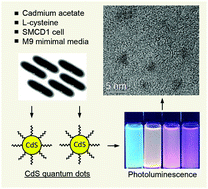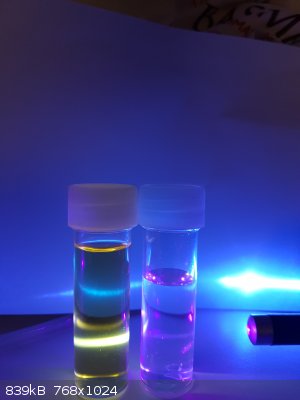chironex
Harmless

Posts: 40
Registered: 17-10-2016
Member Is Offline
Mood: No Mood
|
|
Nanotech article series (some of my work, a review and future outlooks of the field)
I've started writing an article series on the field of nanotechnology. I'm writing it partly to explore the field and show the many cool areas that
often few people know about, and also to show off some of my work on the creation of various nanomaterials. This first article covers quantum dots and
my first experience with a nanomaterial.
Medium article
|
|
|
aga
Forum Drunkard
    
Posts: 7030
Registered: 25-3-2014
Member Is Offline
|
|
Interesting stuff !
According you the link you posted, you made 'quantum dots' in 8 hours using sugar, some plumbing parts and a household oven.
Do you think this could be 'tunable' so that some material made this way could be used as a notch filter at, say 535nm ?
Thinking of the Raman Spectrometry thing.
Edit:
You'll probably get a lot of feedback if you post your work here.
[Edited on 6-11-2016 by aga]
|
|
|
Sulaiman
International Hazard
    
Posts: 3697
Registered: 8-2-2015
Location: 3rd rock from the sun
Member Is Online
|
|
How do I persuade my wife that the pipe bomb next to the meat is perfectly safe darling .....
just like that last experiment with NO2, or the one before with Cl2, not like the one .....
It does look to be a new frontier, exciting but genuinely dangerous.
I lost most of my bravery ages ago ... I'll stay with safer stuff like toxins and exothermics 
CAUTION : Hobby Chemist, not Professional or even Amateur
|
|
|
chironex
Harmless

Posts: 40
Registered: 17-10-2016
Member Is Offline
Mood: No Mood
|
|
Ha! ya the first time I tried this I was terrified but after running it several dozen times, I've never seen it fail spectacularly. normally the seal
between the cap and the main tube fails and the thing just depressurizes. If that happens just take it out with a pair of tongs and cool it under
running water. Drops the pressure and rinses away any goop leaking out. You could worry about stressing the thing, but the iron is fairly strong and
it's not under that much pressure. Or if you're really worried, get one of the nice stainless steel/teflon hydrothermal reactors you can get on ebay
for 40-50 bucks. Those will never fail unless you push them past their recommended limits and even then they'd last a while. I really love
hydrothermal synthesis. You can make such interesting stuff
|
|
|
Sulaiman
International Hazard
    
Posts: 3697
Registered: 8-2-2015
Location: 3rd rock from the sun
Member Is Online
|
|
It must be an exciting new area,
I have noticed a rapid rise in availability of hydrothermal reactors via eBay UK,
but until you posted, I did not know what those expensive little things were for,
I thought deep sea oil related 
presently 160 listings.
How are small entrepreneurs making money ?
CAUTION : Hobby Chemist, not Professional or even Amateur
|
|
|
chironex
Harmless

Posts: 40
Registered: 17-10-2016
Member Is Offline
Mood: No Mood
|
|
Ya the fact that they're so readily available makes the whole subject much more accessible and much safer to study.
Hydrothermal process have been in use for ages, but mostly industrially. The process for converting aluminum ore into aluminum actually contains a
hydro thermal step to dissolve away all the silica from the ore. Most artificial gems are grown in higher power hydrothermal reactors.Only more
recently has it become more popular for nanotech and energy research amongst other things. I'm seeing entrepreneurs use it to develop next generation
materials for super capacitors and batteries. It's also being investigated for new methods of waste treatment. So really it all depends on your
creativity. Maybe use it to develop a new solar cell, or use it to synthesis a compound from a waste product (like acetic acid from cellulose).
I just finished writing my next article, though it isn't on nanotech this time. This time I talk about my time building a fusor and some of my other
plasma experiments. It also touches on something I think most in this community would agree on, that experimentation should be central to learning LINK
EDIT: Forgot to add, I made a gallery of all my best plasma pictures LINK
[Edited on 11-11-2016 by chironex]
|
|
|
careysub
International Hazard
    
Posts: 1339
Registered: 4-8-2014
Location: Coastal Sage Scrub Biome
Member Is Offline
Mood: Lowest quantum state
|
|
Between this and the carbon foam thread, we have the materials of the future being made in kitchens from bread and sugar!
O brave new world that has such people in 't!
About that which we cannot speak, we must remain silent.
-Wittgenstein
Some things can never be spoken
Some things cannot be pronounced
That word does not exist in any language
It will never be uttered by a human mouth
- The Talking Heads
|
|
|
aga
Forum Drunkard
    
Posts: 7030
Registered: 25-3-2014
Member Is Offline
|
|
They sell things for more than they buy them for 
Experimentation in all things yields useful results.
Perhaps someone will do something in their kitchen and post the results ?
[Edited on 12-11-2016 by aga]
|
|
|
chironex
Harmless

Posts: 40
Registered: 17-10-2016
Member Is Offline
Mood: No Mood
|
|
I spent the last year making advanced materials in my kitchen/living room XD. In january I'll be teaching a course down in brazil where I'll get a
chance to both run all the experiments again (with the aid of hindsight this time to improve on what I did) with professional equipment, and to use a
nice camera to film and document it all. It'll also give me a chance to put all the materials to the test and see exactly what they can do. Expect me
to be posting frequently by then. And since it's a totally hands on class, I'm excited to see how much further my students can take my ideas and the
work I've already done. Honestly I'm pretty excited
|
|
|
mayko
International Hazard
    
Posts: 1218
Registered: 17-1-2013
Location: Carrboro, NC
Member Is Offline
Mood: anomalous (Euclid class)
|
|
I ran across this today; eagerly awaiting the convergence of DIY bio and DIY nano !
Yang, Z., Lu, L., Berard, V. F., He, Q., Kiely, C., Berger, B. W., & McIntosh, S. (2015). Biomanufacturing of CdS quantum dots. Green Chem.,
17(7), 3775–3782. http://doi.org/10.1039/C5GC00194C
| Quote: |
Nature provides powerful but as-yet largely unharnessed methods for low-cost, green synthesis of inorganic functional materials such as quantum dots.
These materials have diverse applications from medicine to renewable energy. Harnessing nature's unique ability to achieve cost effective and scalable
manufacturing solutions with reduced environmental impact is integral to realizing a future biomanufacturing economy. To address this challenge, a
bacterial strain has been engineered to enable biosynthesis of CdS nanocrystals with extrinsic crystallite size control in the quantum confinement
range. This strain yields extracellular, water-soluble quantum dots from low-cost precursors at ambient temperatures and pressure. The
biomanufacturing approach demonstrated here produces CdS semiconductor nanocrystals with associated size-dependent band gap and photoluminescent
properties.
|

Attachment: Biomanufacturing of CdS quantum dots.pdf (4MB)
This file has been downloaded 545 times
al-khemie is not a terrorist organization
"Chemicals, chemicals... I need chemicals!" - George Hayduke
"Wubbalubba dub-dub!" - Rick Sanchez
|
|
|
chironex
Harmless

Posts: 40
Registered: 17-10-2016
Member Is Offline
Mood: No Mood
|
|
That's super cool! I've seen a few articles on using biology to generate nanoparticles. I'm really interested in using biology to more carefully
control the morphology of particles. The silicate structures of diatoms and stuff are the coolest example. If we could do the same with magnetic,
conductive or catalytic materials, could make for some interesting things, and give them interesting properties.
I wrote another article though this one is really more biology than chemisty. I talk about a process called decellularization and some of my work on
it. medium article
|
|
|
PHILOU Zrealone
International Hazard
    
Posts: 2893
Registered: 20-5-2002
Location: Brussel
Member Is Offline
Mood: Bis-diazo-dinitro-hydroquinonic
|
|
No fluorescence or phosphorescence but related...
Colloidal gold is the purple stuf used into pregnancy tests when into contact with specific molecules it aggregates into larger globules and is then
blue.
nano gold colour
colloidal gold
PH Z (PHILOU Zrealone)
"Physic is all what never works; Chemistry is all what stinks and explodes!"-"Life that deadly disease, sexually transmitted."(W.Allen)
|
|
|
aga
Forum Drunkard
    
Posts: 7030
Registered: 25-3-2014
Member Is Offline
|
|
Huh ? I thought the pregnancy test checked for human chorionic gonadatropin ?
|
|
|
chironex
Harmless

Posts: 40
Registered: 17-10-2016
Member Is Offline
Mood: No Mood
|
|
It would depend on the test. I've seen some aptamer based systems that work the way PHILOU Zrealone was describing. Aptamers are generally really
great for stuff like that. Another method uses a longer aptamer chain that has half a GFP unit on either end. When it comes in contact with it's
target molecule the aptamer wraps around it, which brings the two parts of the GFP together allowing it to fluoresce. But I'm sure there are other
ways to do it.
|
|
|
Harristotle
Hazard to Others
  
Posts: 138
Registered: 30-10-2011
Location: Tinkerville
Member Is Offline
Mood: I tink therefore I am
|
|
I am really keen to not intrude into your territory chironex, but you have absolutely opened up a new world of chemistry for me. The night after you
first posted, I ordered an autoclave - one of these things, but 50ml (http://www.ebay.com/itm/Hydrothermal-Synthesis-Autoclave-Rea...).
Next, I grabbed a copy of Paikaray and Moharana's masters thesis (http://ethesis.nitrkl.ac.in/4627/1/411CY2027.pdf) and avidly read it, in doing so thieving as many references as I could. This led me to the 2012
RSC paper on making graphene quantum dots from orange juice. (Simple one-step synthesis of highly luminescent carbon dots from
orange juice: Application as excellent bio-imaging agents ).
I was hooked! I used the sucrose/ethanol method from the above thesis, with a tweak or two (5% sucrose, 30% M/Ethanol; autoclaved at 150 degrees C for
3h).
The results are below: Here is a 405nm laser showing strong fluorescence in diluted 1:20 reaction mix.
Thanks for your inspiration - this is really easy to do, and really rewarding.

|
|
|
chironex
Harmless

Posts: 40
Registered: 17-10-2016
Member Is Offline
Mood: No Mood
|
|
Pft forget that, intrude all you like. I posted the article specifically so that people might get interested in hydrothermal chemistry. I was so
fascinated by it when I first found it. Awesome job on the quantum dots. You'll find that they form from pretty much any carbon source you put in
there. You may want to ty growing a layer of graphene oxide now that you've got the reactor. You may have noticed a shiny film on the surface of the
liquid when you first opened it up. That is a layer of graphene oxide. It's called the tang lau method.
If you feel like doing a fun reaction (its not really that useful, but the produce is neat) try this one Sparkly copper particles
Let it run for 6-10 hours and as soon as it's finished, transfer the particles to a dilute ascorbic acid solution to prevent them from oxidizing.
|
|
|